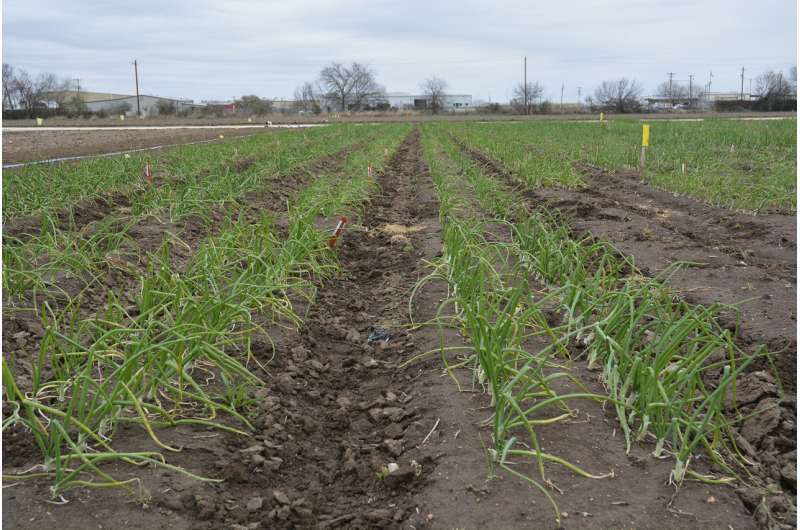Study shows plant growth regulators can benefit onion establishment, production

A study by researchers at the Texas A&M AgriLife Research and Extension Center in Uvalde shows the use of externally introduced plant growth regulators can have a positive effect on onion germination and root structure.
The study, "Enhancing Onion Seed Germination and Root Traits by Plant Growth Regulators," was conducted by Andrea Macias, graduate research assistant with Texas A&M AgriLife Research, in collaboration with Dr. Daniel Leskovar, center director and plant physiologist. The research will appear in an upcoming issue of HortScience, a journal publication of the American Society for Horticultural Science.
"Improving root development during early stages will allow seedlings to take in water and nutrients more efficiently so the plant can grow and produce more quickly, while reducing the risk of early stresses," Leskovar said. "For onion producers, this can shorten the amount of time the onions are in the ground, with potential improvements in early stands."
The objective of this study was to evaluate the effect of selected plant growth regulators on seed germination rate and root traits of onion seedlings, Macias said.
"Previous research showed onions are easily outcompeted by weeds due to slow germination and relative growth rate, which resulted in a smaller bulb size and less homogenous plant populations," she explained.
She also noted onions produce few lateral roots and lack root hairs, which hinder nutrient and water uptake.
"Roots are important for water and nutrient acquisition, anchoring the plant, soil microbial interaction and reserve storage," Macias explained. "High seed germination and root vigor are important traits to improve post-transplant performance of onions."
She said the study hypothesized that improving seed germination and root architecture could help plants overcome nutrient and water limitations and mitigate abiotic, or non-biological, environmental stresses such as temperature, flood, drought and salinity.
Macias said past studies showed endogenous plant growth regulators control germination and seedling growth, but there was still a need to better understand the impact of exogenous hormones—those originating outside of an organism.
"We still needed to figure out these effects, individually or synergistically, on root architecture and initiation, as well as the primary, lateral, adventitious and root hair development," she said.
The study used two onion cultivars – the Lambada, a red globe-shaped onion, and the Don Victor, a round yellow variety. The effects of two exogenous plant growth regulators, 2-chloroethylphosphonic acid, known as ethephon or ETH, and 3-idoleacetic acid, known as Auxin, or IAA, were evaluated on germination and early root growth of the two varieties.
There was also a hydro-primed, or water irrigated, group and control group.
Research results showed seed germination was significantly improved by the application of the ethephon and IAA combination and the medium concentration of IAA.
"Germination percentage was similar among treatments as compared to the control, except for a slight reduction with the highest concentration of ethephon," Macias said. "And mean days of germination were significantly shortened by various concentrations of ethephon and the ethephon and IAA combination as compared to the control. Only the medium concentration of IAA showed a significant reduction in amount of time."
She also noted the addition of IAA to ethephon improved the germination effect of ethephonalone alone and hydro-priming also reduced mean days of germination.
"Root surface area was also enhanced by concentrations of ethephon, ethephon and IAA and the medium concentration of IAA," Macias said. "But conversely, the same range of concentrations of ethephon reduced primary root growth and average diameter, but IAA showed no effect.
She said the study also showed ethephon and the ethephon and IAA combination reduced root length and root diameter as concentrations increased, but root surface area increased even with the low concentration of ethephon.
"We noted that root trait responses were dependent on ethephon concentration and that hydro- priming increased root length and diameter, but did not improve root surface area," she said.
Macias said the study demonstrated ethephon proved beneficial to increasing onion root surface area at a moderate concentration and the addition of IAA could potentially mitigate reductions in root length and diameter in response to a single application of ethephon.
"Our results suggest that exogenous plant growth regulators could be useful to enhance germination and root traits of onion seedlings, which in turn may improve early growth during stand establishment," she said "We also concluded hydro-priming is a simple and viable method of improving root and germination traits."
Journal information: HortScience
Provided by Texas A&M University




















